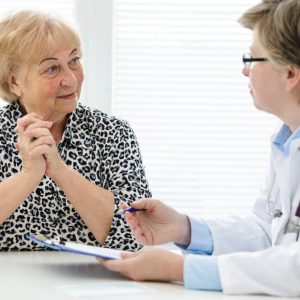When Less Is More: Why Less Treatment, Or Even No Treatment, May Be The Right Choice For You By Julie Buyon

When Less Is More: Why Less Treatment, Or Even No Treatment, May Be The Right Choice For You By Julie Buyon
September 9, 2020
by agebuzz Contributing Editor Julie Buyon
The first question I asked my doctor following my third cancer diagnosis was, “What will happen if we do nothing?” After the doctor picked his jaw up from the floor, his answer was, “Well, I’m not really sure.” We then discussed what my treatment options were — including no invasive treatment at all.
Understanding what is likely to happen with no active treatment of an illness provides you a reference point against which other treatment options may be considered. And the “no treatment option” should be discussed in the context of how it fits your goals for your care. What I mean by your “goals for your care” is identifying what is most important in how you want to live your life and using medicine to help you meet those goals. Those goals should be more specific than “I want to feel better” or “I want to live as long as possible.” They should be about how you want to live your life. For example, my 72-year-old friend Lisa’s goals are to be able to help care for her grandchildren, make art, live without pain, hike, and travel. For Lisa, mobility and pain are most relevant to continuing to do her desired activities as long as possible, as they are what give her life meaning, purpose, and happiness.
For some illnesses, including some cancers, keeping a close eye on things may be a preferred option to more invasive treatment. This approach is called “watchful waiting” or “active surveillance.” Treatment guidelines for prostate cancer, for example, have shifted dramatically since the 1990s, with many patients being able to safely avoid invasive, and sometimes debilitating, treatments by waiting to see if their cancer begins to grow or become problematic. Not every problem, serious as it may sound, requires a big intervention immediately. And many, many people die with an illness like diabetes or cancer, rather than from an illness like diabetes or cancer.
Also, be aware that there are powerful forces at work pushing for tests and treatments, not the least of which are financial incentives in our fee-for-service health care system, which rewards intervention as well as the availability of the latest and “greatest” technology. Take, for example, 3D mammography. Is a 3D mammogram superior to a 2D mammogram? There’s conflicting evidence, and there’s also an awful lot of financial investment in convincing both clinicians and patients that it is. Some evidence indicates that 3D mammography finds more small cancers than 2D. While that sounds great, former Chief Medical and Scientific Officer of the American Cancer Society, Otis Brawley, points out that, “Diagnosing more cancers doesn’t necessarily help women…because not all breast tumors are life-threatening; some grow so slowly that women would live just as long if they ignored them ― or never even knew they were there. Finding these tumors often leads women to undergo treatments they don’t need.”
So always try to ask your doctor for the reasons they are recommending a particular test or course of treatment. Inquire if there is any clinical controversy about its effectiveness as well as whether something less invasive (or less expensive) might be a reasonable choice. Remember, you are the expert about your body– and what might be the right test or treatment for thousands of other people may not be right for you and your circumstances.
Whether it’s 3D or 2D, New York Times Personal Health columnist Jane Brody questions the benefit of getting mammograms for women over 75 at all. Her column is well worth reading in full. It’s a great model for how a Powerhouse Patient can evaluate the existing evidence for a specific intervention (not just mammograms). And agebuzz readers may remember reading about Choosing Wisely in an earlier post, a campaign (with a website and app) that promotes conversation between patients and clinicians about which tests and treatments are necessary and appropriate for them.
But back to doing “nothing.” Many common issues, such as back pain, are likely to get better on their own, with time. Nonetheless, lots of folks have expensive imaging, take pills that may have problematic side effects, and spend money on massage, acupuncture, chiropractors, special cushions et al- all for discomfort that has a good chance of going away by itself. And without a baseline, you won’t really know if the pills, massage, or seat cushion fixed your back pain or made you feel better while actually your body was healing itself. Of course, many health issues won’t get better on their own, but unless you ask “what is likely to happen if I do nothing,” you lack that important reference point.
Considering doing “nothing” may also prompt you and your doctor to more fully assess how you want to live your life and how possible treatments (or lack thereof) support your goals. A 40-year-old with kids at home may find certain treatment side effects acceptable while an 80-year-old with the same diagnosis may not. And “nothing” may equal “least invasive.” A person who has suffered difficult side effects from a previous treatment (even for an unrelated illness) may evaluate his or her treatment options differently than someone who hasn’t had that experience. The benefits and burdens of any treatment are as individual as you are, and you deserve all the information possible to determine what is right for you, including – and especially – what is likely to happen by doing “nothing.”







